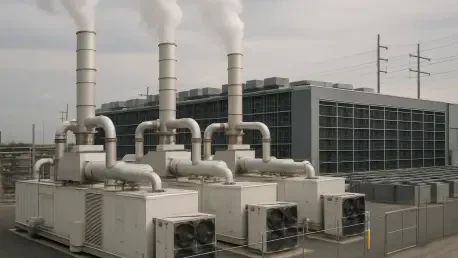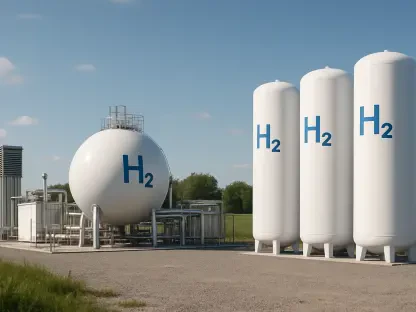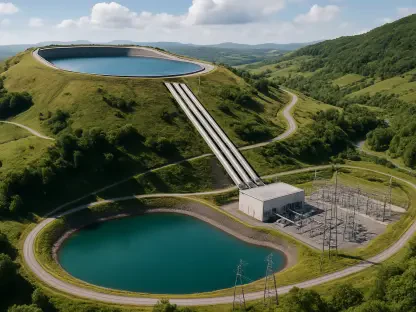What happens when the relentless hunger for artificial intelligence collides with a power grid that can’t keep up? In the vast, open plains of Shackelford County, Texas, two tech giants, OpenAI and Oracle, are forging an audacious answer by partnering to build a colossal data center powered not by the public grid, but by a self-sufficient natural gas microgrid—a move that could redefine how AI infrastructure is fueled. This isn’t just a tech project; it’s a glimpse into a future where energy innovation becomes as critical as code.
The significance of this endeavor, known as the Stargate data center, cannot be overstated. As AI models grow more complex, their energy demands have skyrocketed, pushing data centers to consume electricity on a scale equivalent to small cities. Yet, with grid connection delays stretching up to five years in some regions, according to the Lawrence Berkeley National Laboratory, waiting for traditional power solutions risks stalling progress in a fiercely competitive field. This project stands as a daring solution, highlighting a seismic shift in how tech giants are tackling the energy crisis to maintain their edge.
Why Tech Giants Are Betting on Gas-Powered Solutions
The AI boom has unleashed an unprecedented strain on energy resources, prompting companies to rethink their power strategies. Data centers, the backbone of AI operations, now account for a significant chunk of global electricity use, with consumption expected to double by the end of this decade. For OpenAI and Oracle, relying on an overstretched public grid isn’t just impractical—it’s a direct threat to innovation timelines. Turning to natural gas microgrids offers a way to sidestep these bottlenecks, ensuring that their cutting-edge projects don’t grind to a halt.
This pivot isn’t merely a reaction; it’s a calculated strategy to stay ahead. By generating their own power, these companies can control their destiny, avoiding the uncertainty of grid upgrades that lag behind technological advancements. In Texas, where energy regulations are often more flexible, the choice of location adds another layer of advantage, allowing for quicker deployment of such unconventional solutions.
Unpacking the Energy Crisis Fueling AI’s Growth
Behind the glossy promise of AI lies a gritty reality: the U.S. power infrastructure is buckling under pressure. Data centers running sophisticated algorithms devour electricity at a staggering rate, with some estimates suggesting a single facility can use as much power as 100,000 homes. The problem is compounded by systemic delays—grid connections in high-demand areas can take half a decade, a timeline that clashes with the rapid pace of tech development.
This mismatch has far-reaching consequences beyond corporate boardrooms. As more industries integrate AI, from healthcare to finance, the ripple effects of energy shortages could slow societal advancements. The urgency to address this gap has pushed tech leaders to explore off-grid alternatives, setting the stage for projects like the one in Shackelford County to become potential blueprints for others facing similar hurdles.
Inside Stargate: A Glimpse at a Gas-Powered Marvel
Nestled in the heart of Texas, the Stargate data center represents a fusion of ambition and necessity. Spanning 3.7 million square feet across 10 buildings, this mega-campus, dubbed “Frontier” by partner Vantage Data Centers, is designed to operate entirely off the public grid. A natural gas microgrid, developed with energy startup Voltagrid, will initially deliver 700 megawatts of power—enough to rival the needs of a small city—with plans to scale up to 1.4 gigawatts in the near future.
The technical setup is equally impressive. A fleet of 210 industrial gas generators, crafted by Austrian manufacturer Jenbacher, will drive the facility, with most units dedicated to primary power and a select few reserved for emergencies. This infrastructure not only ensures reliability but also positions the project as a trailblazer in energy autonomy, reflecting a growing trend among tech giants to take power generation into their own hands.
Slated to be operational by next year, the Shackelford County site builds on lessons from an earlier Stargate facility in Abilene, Texas, which also uses gas generators. Industry peers, including Elon Musk with xAI’s projects in Memphis and Mississippi, are watching closely, signaling that this approach might soon become a standard for AI infrastructure across the nation.
Industry Leaders Speak: Vision Behind the Venture
The scope of this initiative is matched by the boldness of its visionaries. Sam Altman, CEO of OpenAI, has articulated a goal to push Stargate’s capacity beyond 10 gigawatts, a target that would dwarf most existing data centers. His comments reflect a belief that the future of AI hinges not just on algorithms, but on the ability to secure massive, reliable energy sources—a perspective that resonates across the sector.
Insights from project partners further illuminate the strategic depth of this collaboration. Internal planning documents, such as those from Oracle, reveal meticulous coordination with specialists like Voltagrid, whose expertise in microgrid technology has been pivotal. These voices collectively underscore a shared conviction: in an era where grid limitations threaten to derail progress, self-generated power isn’t a luxury—it’s an imperative for survival in the AI race.
Lessons from Stargate: Shaping the Future of AI Infrastructure
The Stargate project offers a wealth of insights for an industry at a crossroads. One clear takeaway is the viability of private energy solutions as a means to bypass grid delays. Companies facing similar challenges could partner with energy innovators to design custom microgrids, ensuring that critical facilities come online without years of waiting.
Speed remains a critical factor. By generating power onsite, tech firms can slash deployment timelines significantly, a lesson OpenAI and Oracle are putting into practice with a target operational date just around the corner. This approach could inspire others to prioritize rapid infrastructure rollout over traditional dependencies.
Collaboration also emerges as a cornerstone of success. The synergy between OpenAI, Oracle, Vantage Data Centers, and Voltagrid demonstrates how blending tech ambitions with energy expertise can address complex challenges. For businesses eyeing similar ventures, forging strategic alliances could be the key to navigating the uncharted terrain of AI’s energy demands.
Looking ahead, scalability stands out as a guiding principle. Starting at 700 megawatts with aspirations for exponential growth, this initiative highlights the need to plan for long-term capacity from the outset. Industry players would do well to assess future needs early, building flexibility into their designs to avoid constraints down the line.
Reflecting on a Bold Leap Forward
Looking back, the journey of OpenAI and Oracle in Shackelford County marked a pivotal moment in the intersection of technology and energy. Their decision to harness a natural gas microgrid for the Stargate data center addressed immediate operational hurdles while setting a precedent for others in the field. It was a testament to the lengths companies would go to fuel the AI revolution.
As the industry moved forward from that point, the focus shifted toward refining these private energy models to balance efficiency with broader societal impacts. Stakeholders were encouraged to explore hybrid power solutions that could integrate renewables, reducing reliance on fossil fuels over time. Policymakers, too, had a role in updating grid infrastructure to better support tech growth, ensuring that energy autonomy didn’t become a permanent divide between corporate giants and public systems. This pioneering step was just the beginning of a larger conversation about powering innovation sustainably.









